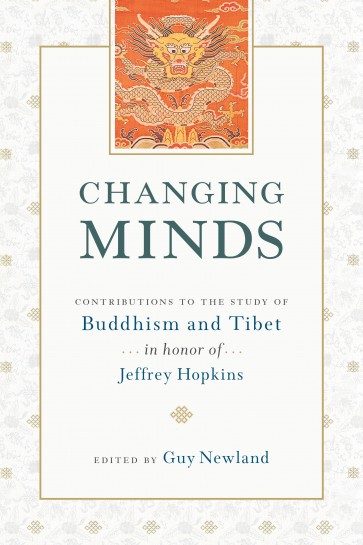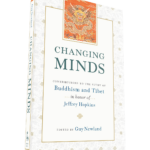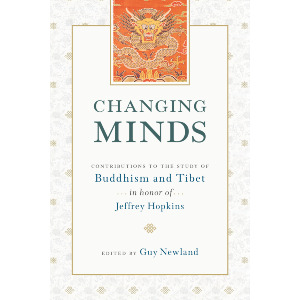| The following article is from the Spring, 2001 issue of the Snow Lion Newsletter and is for historical reference only. You can see this in context of the original newsletter here. |
Contributions to the Study of Buddhism and Tibet In Honor of Jeffrey Hopkins

This is a book offered in tribute to Jeffrey Hopkins by colleagues and former students. Jeffrey Hopkins has, in his sixty years, made profound and diverse contributions to the understanding of Tibet and Tibetan Buddhism in the West. In his collaborations with the Dalai Lama, such as Kindness, Clarity, and Insight, and in books like Tibetan Arts of Love and Emptiness Yoga, Hopkins has reached out to the general reader, making the wisdom of Tibet accessible to every one. Yet there is never anything superficial about his work; his recent Emptiness in the Mind-Only School is a magisterial display of painstaking scholarly work.
Changing Minds contains essays that reflect the breadth and influence of Hopkins.
The following is an excerpt from the Editor's Introduction.
Twenty-five years ago I first met Jeffrey Hopkins as my instructor in a popular undergraduate course on Buddhist meditation at the University of Virginia. 1 liked the course and studied with him for almost thirteen yearsbecause of the way Hopkins presented Buddhist ideas. He did not posture as the authoritative curator of a mummified body of knowledge. He did not mystify the tradition and he certainly did not act as a missionary for it. On the other hand, he did not attempt to account for Buddhism in terms of any extrinsic academic ideology. Instead, Hopkins was interested in encountering Buddhist worldviews as living systems of human meaning; his classes were invitations to participate in that encoimter. They were based on his own meticulous translations of primary-source Tibetan or Sanskrit texts, sometimes produced in collaboration with Tibetan colleagues. The message that I got, from his teaching and his books, was: There are and long have been real people, whole communities and civilizations, for whom the ideas and texts we are now studying are profoundly important. We should show them the respect of taking their ideas seriously. That means finding out how far we can go in understanding how others make sense of the worldand seeing how our minds change in the process.
Hopkins presented Tibetan Buddhism as a living system of meaning in part by bringing to campus distinguished Tibetan scholars from the refugee communities of India. At that time, in the middle of the 1970s, this was something quite rare; most of my fellow undergraduates had heard the term Dalai Lama only as a Johnny Carson punch-line. Sometimes a monk would accompany Hopkins to class and speak to us in Tibetan, with Hopkins translating. Hopkins taught many undergraduate and graduate courses in this way while I was at the University of Virginia. There is no doubt that the presence of visiting Tibetan scholars on campus greatly enriched my education in the graduate Buddhist Studies program. Instead of having only Hopkins representing and mediating Tibetan Buddhism to us, we had continuing opportunities to work with scholars whose credentials to speak from within and on behalf of the tradition were unimpeachable. Some graduate students in the program likely developed, outside of class, spiritual connections with these lamas that were deeper and more important to them than their academic relationship with Hopkins.
That was not my experience; I was not drawn into the program mainly by the Tibetan scholars. After all, they could not speak English and only Hopkins and the more advanced graduate students could really question them directly. For me, the heart of the program was Hopkins. He had no superficial flash as a public speaker, but he had intellectual substance and passion. He conveyed his prodigious learning with an intensity that John Buescher conjures from the past in the opening article of this volume. Buescher gives us Hopkins at workguiding students through the complexities of Sanskrit syntax, teaching them how to pull from the tangle something that would change their minds:
It's the self of persons and of things
that we're looking for, Jeffrey said, as he pointed to Nagarj una's text in front of him. The tiling that seems to cover over them and make them a whole, single entity, assembling things out of their parts. We've got to take them apart to see it. Parsing the words of the text, then translating them, the operation became unexpectedly exacting. Sweat rolled down in tight, little streams under my shirt. We were unprepared for this drill, this scalpel. Jeffrey, however, proceeded on, laying bare our ignorance, peremptorily rejecting any uncertain or wrong answer. As he thundered his demand for the right answer, we searched for it. We desperately wished we could find it, some seat of the soul, some little treasure amid the remains of the words that now lay in pieces all about us.
Did these teaching methods leave room for students to challenge the tradition itself, to form their own critical evaluation of it? In my undergraduate courses with Hopkins, he seemed to regard it as satisfactory if a student could think through some of the complexities of Tibetan Buddhist doctrine. He certainly did not forbid etic analysis or independent critique, but he did little to encourage it. This might not seem ideal, but it did not strike me as so different from many other courses that I had taken, in Russian literature, Greek tragedy, or experimental psychology, for example. In each case, the premise was that there is a very complicated, very unfamiliar story to be told. The novice must expect to spend time on the ground of the storyteller, learning the story well and getting the details straight, before launching an idiosyncratic metanar- rative on what the story (in this case someone else's religion) is really about.
As a graduate student, my experience was that Hopkins wanted even demandedwork that was not only intimately grounded in the details of the tradition, but also had something to say, something useful or insightful. As I gained mastery of a research topic (and not before), he clearly expected more of me than a re-transmission of what learned lamas had said. For example, he told me that my seminar paper on the Abhisamayalamkara was boring because it simply reorganized information from the tradition. On another occasion, Hopkins asked me to present a paper in an interdepartmental colloquium series, assigning me a topic from the work of the Sa skya scholar sTag tshang. I decided on my own that I would instead give a psychoanalytic treatment of Tsong kha pa on the three principal aspects of the path. When he heard my talk, rather than being upset that I had presumed to offer an independent analysis, he was clearly pleased. The same was true when I submitted my dissertation; when I used various Western theories to give an independent account of the religiosity of dGe lugs scholasticism, Hopkins's criticisms were aimed only at strengthening my argument.
Hopkins's scholarship likewise evidences concern to avoid arrogant pseudo-objectivity on the one hand and naive adulation on the other. Hopkins has taken special pains to avoid the first of these extremes and has been more careful in that regard than some. By being open in his appreciation for some aspects of the traditions he studies, Hopkins has at times chosen to risk appearing to some as an academic front-man for religious dogma. In books such as Meditation on Emptiness and The Tantric Distinction, Buddhist thought-systems are not specimens to be dissected at arm's length. Instead, Hopkins recreates his encounter with another world of meaning, a very particular and intricate Asian Buddhist world which can never again be imagined as completely separate from our world. Describing his version of a methodological middle way, Hopkins writes that his aim is to evince a respect for the directions, goals, and horizons of the culture itself without swallowing an Asian tradition as if it had all the answers or...pretending to have a privileged position.
* * *
Don Lopez and Joe Wilson conceived that this book should come into being to honor Jeffrey Hopkins in his sixtieth year. At their suggestion and with the encouragement of Anne Klein, I undertook the project, soliciting contributions only from a close circle of Hopkins's friends, admirers, and former students. Then, with some assistance from Snow Lion and outside readers, I selected the articles in this volume for publication. As Paul Hackett shows in the closing article of this volume, Hopkins's research has covered a wide range of concerns, centering on dGe lugs scholarship but ranging far beyond it in several directions. A thin cross-section of that diversity is reflected in the scholarship here.

Describing his version I of a methodological middle way, Hopkins writes that his aim is to evince a respect for the directions, goals, and horizons of the culture itself without t swallowing an Asian tradition as if it had all the answers or... pretending to have a privileged position.
John Buescher opens our volume with an atmospheric and evocative real-life detective story. Caught in the act of teaching Madhyamika Buddhism, Hopkins appears as a philosophical sleuth on the trail of truth. Buescher then weaves into this portrait its unexpected resonances, years later, in a baffling international news-eventthe sudden appearance of a previously unknown dental relic of the Buddha.
The Madhyamika theme continues through the next two articles, by Guy Newland and Donald Lopez. My article is inspired in part by the efforts of Hopkins to describe the Madhyamika view for a general readership. I summarize some of the philosophical claims Tsong kha makes in Lam rim chen mo, reflecting in particular on the notion of conventional reality. Lopez's piece distills a careful synopsis of Tsong kha pa's treatment of the object of negation (dgag bya) in Madhyamika analysis. Then, based on his own new translations, he treats us to a riveting critique of this position by the brilliant twentieth-century iconoclast, dGe dun Chos phel.
Contributions by Dan Cozort and Elizabeth Napper keep the focus on Tsong kha pa and his Lam rim chen mo, but move away from Madhyamika Cozort provides a useful, clear, and detailed analysis of Tsong kha pa on the special dangers of anger, which is said to cut the roots of virtue. What, exactly, does this mean? How deep is the damage of anger? Cozort finds Tsong kha pa working with mixed success to explicate this doctrine and integrate it into his system. Like Cozort, Napper scrutinizes Lam rim chen mo in her contribution, Ethics as the Basis of a Tantric Tradition: Tsong kha pa and the Founding of the dGe lugs Order in Tibet. She lays out exactly how Tsong kha pa used his sources, subtly and skillfully reshaping grammar, nuance, and context in order to build a new and unique system of religious meaning. She concludes with some frank observations about the impact that the distinctive features of this system (such as its emphasis on monastic ethics) have had on the later tradition. Nap- per's impeccable work, synthesizing insights from many years of work with Lam rim chen mo and its sources, merits the appreciation of everyone who studies the dGe lugs order.
The next pair of articles shift our attention to the contemplative traditions of rDzogs chen and Mahamudra. Anne Klein takes us into the realm of Bon rDzogs chen poetry. Her original translations gracefully depict a natural, open awarenessunrecognized by ordinary personsin which reality is experienced as spontaneous and unbounded wholeness. She carefully explains who reads such poetry, to what end, and she compares the handling of contradiction and nonduality in Buddhist Madhyamika with that in Bon rDzogs chen. Roger Jackson then gives us an outstanding treatment of a little- known topic, the tradition of dGe lugs Mahamudra (phyag rgya chen po). As he notes, Mahamudra is more usually associated with meditative practices central to the bKa' brgyud tradition of Tibetan Buddhism. Questions about the role of and basis for a dGe lugs form of Mahamudra lead Jackson to broader insights about inter-sectarian connections.
As Hopkins suggests, our understanding of early dGe lugs has been much aided by recent advances in our grasp on the teachings of Shes rab rgyal mtshan and the Jo nang other emptiness doctrine. Here we offer two articles which touch on this issue, demonstrating how the self-empty vs. other-empty controversy set the stage for otherwise disparate debates. Displaying his formidable knowledge of Tibetan Perfection of Wisdom literature, Gareth Sparham shows how debates about the authorship and authority of key commentaries evolved within the context of controversy between dGe lugs and Jo nang views. Then, Joe Wilson gives us a generous and cogent explication of how and why the concept of a basis-of-all (alay- avijnana, kun gzhi rnam par shes pa) is subject to radically different constructions in the Jo nang and dGe lugs traditions.
While cross-cultural and comparative themes are touched upon in other contributions, Jose Cabezon and Harvey Aronson bring them into focus. Cabezon analyzes the structure and content of Tibetan colophons, looking for evidence of an implicit theory of authorship and literary production. Simplistic notions of authorship are quickly problema- tized by the multiple layers of productivity through which a book is generated. Cabezon has given us a unique and nuanced study, full of allusions to and connections with the conversations of Western literary theory. Such cross-cultural comparison arises from historical contact; in the case of Tibetan Buddhism, that contact includes the unprecedented phenomenon of large numbers of Westerners taking up Buddhist practices and striving to embody Buddhist virtues. Using object-relations theory and his own experience as a clinician, Harvey Aronson warns of the pathological pitfalls that may afflict the self-sacrificing American bodhisattva, but argues for a model of healthy altruism.
Our volume concludes with Paul Hackett's comprehensive survey of the published works of Jeffrey Hopkins. We are grateful to Hackett for an ambitious essay charting the range and depth of Hopkins's oeuvre. Inasmuch as Hopkins's recently published Emptiness in the Mind-Only School has been hailed by many as his best work ever, and inasmuch as it is the first of a tliree-volume series, Hackett's work will perhaps but serve as a starting point for future bibliographic analysis.
In sum, this volume is presented as a tribute to the work of Jeffrey Hopkins as a teacher and as a scholar. Paul Hackett has written eloquently of Hopkins's impact:
Most people who have pursued knowledge and learning would be hard pressed not to remember at least one teacher sometime, somewhere, who first inspired them and instilled in them a sense of value in learning. This ability, the capacity not only to convey meaning, but also to motivate remains an art which stands apart from mere erudition. For some, it comes naturally; for others it requires effort; though in each person who manages to master it, there is always evident an idiosyncratic artistry by which their knowledge and experience is conveyed. So it is with Jeffrey Hopkins, who has repeatedly demonstrated not only his depth of knowledge, but also his skill as a teacher and writer.
As we see in this volume, he has inspired and enlivened us in many different ways. So now we say: Thank you!


